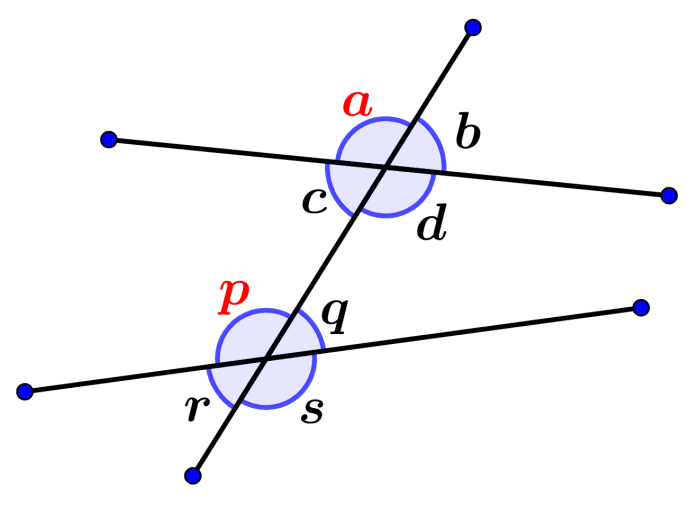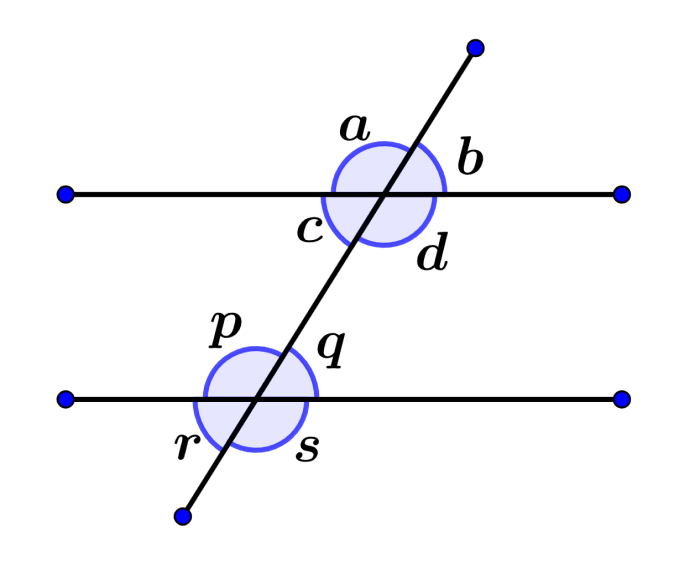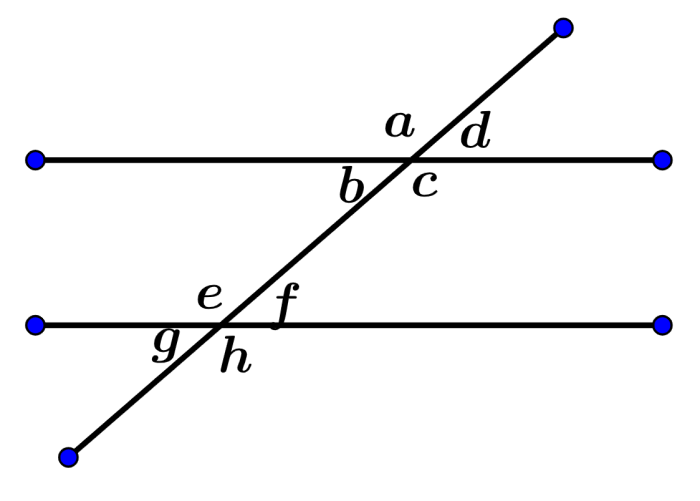Before we start with the corresponding angles directly, we have to do a brief review of the angles, the parallel and non-parallel lines, and the transverse lines.
In geometry, an angle is made up of three parts: a vertex and two sides or segments. The vertex of an angle is the point where two sides or lines of the angle meet, while the sides are simply the line segments.
Parallel lines are two or more lines in the 2D plane that never intersect. These lines have the same slope. On the other hand, non-parallel lines are two or more lines that intersect. A transverse line is a line that passes through two parallel or non-parallel lines.
What are the corresponding angles?
Corresponding angles are angles formed when a transverse line crosses two straight lines. These angles are formed at equivalent corners or at corners corresponding to the transversal when two lines are intersected by a third line.
For example, in the following figure, the angles a and p are corresponding.

The transversal can intersect both two parallel lines and two non-parallel lines. Therefore, the corresponding angles can be of two types:
- Corresponding angles formed by parallel lines and a transversal
- Corresponding angles formed by non-parallel lines and a transversal
Here, we will learn about these two types of corresponding angles.
Corresponding angles between parallel and transversal
If a transverse line crosses two parallel lines, then the corresponding angles formed have the same measure. In the diagram below, we can see that the two parallel lines are intersected by a transversal, which forms eight angles with the transversal.
Therefore, the angles formed by the first line with the transversal have the same corresponding angles formed by the second line with the transversal.

All pairs of corresponding angles in the figure are:
- ∠a and ∠p
- ∠c and ∠q
- ∠c and ∠r
- ∠d and ∠s
We know that the corresponding angles formed by two parallel lines are always equal. Therefore, we have:
- ∠a = ∠p
- ∠c = ∠q
- ∠c = ∠r
- ∠d = ∠s
Corresponding angles formed by non-parallel and transverse lines
If a transverse line intersects two non-parallel lines, the corresponding angles formed have no relation to each other. These angles are not the same as in the case of the angles formed by parallel lines, but they do correspond to each other.

In the same way, in the case of an intersection of two non-parallel lines with a transverse line, there is no relationship between the internal angles, the external angles, the opposite vertical angles, and the consecutive angles.
Corresponding angle examples with answers
The following examples show how problems involving corresponding angles can be solved. A very useful technique is to draw a diagram to find the rest of the angles easily.
EXAMPLE 1
If we have that the angle d in the following diagram is equal to 40 °, find the rest of the angles.

Solution: We have the angle ∠d = 40°. We know that the vertical opposite angles are equal, so we have:
∠d = ∠b
⇒ ∠b = 40°
We know that the corresponding angles are also equal, so we have:
∠b = ∠ g= 40°
and also
∠d = ∠ f= 40°
Using the supplementary angles, we have:
∠ b + ∠ a = 180°
∠a+ 40° = 180°
∠ a = 140°
Again, using corresponding angles, we have:
∠ a = ∠ e = 140°
and also
∠d = ∠h = 40°
EXAMPLE 2
The two corresponding angles of a figure formed by parallel lines measure 8x + 10 and 58. Find the value of x.
Solution: We know that the corresponding angles formed by parallel lines are always congruent, so we have:
8x + 10 = 58
8x = 58 – 10
8x = 48
x = 6
EXAMPLE 3
The two corresponding angles of a figure made of parallel lines measure 7y – 12 and 5y + 6. Find the magnitude of a corresponding angle.
Solution: First, we have to find the value of y. We know that the two corresponding angles measure the same, so we have:
7y – 12 = 5y + 6
7y – 5y = 6 + 12
2y = 18
y = 9
Now, we have to substitute this value in one of the angles:
7y – 12 = 7(9) -12 = 51
See also
Interested in learning more about angles? Take a look at these pages:



